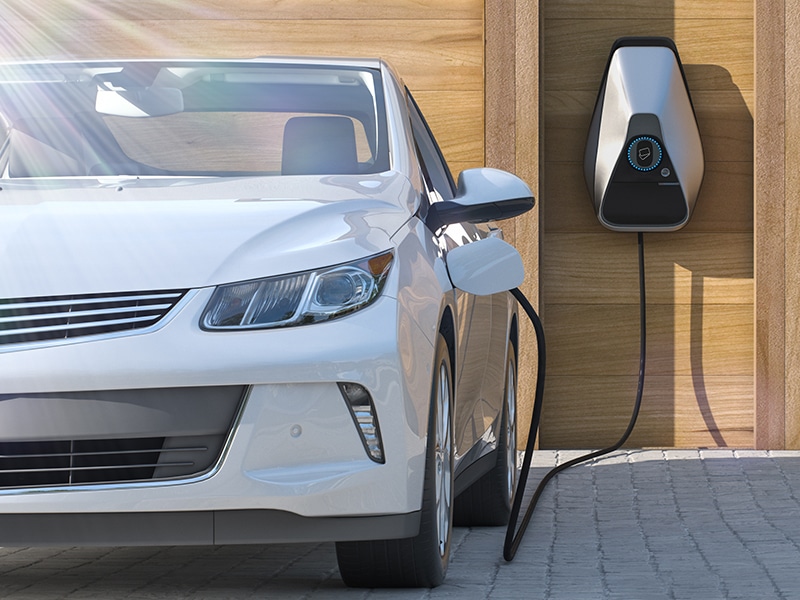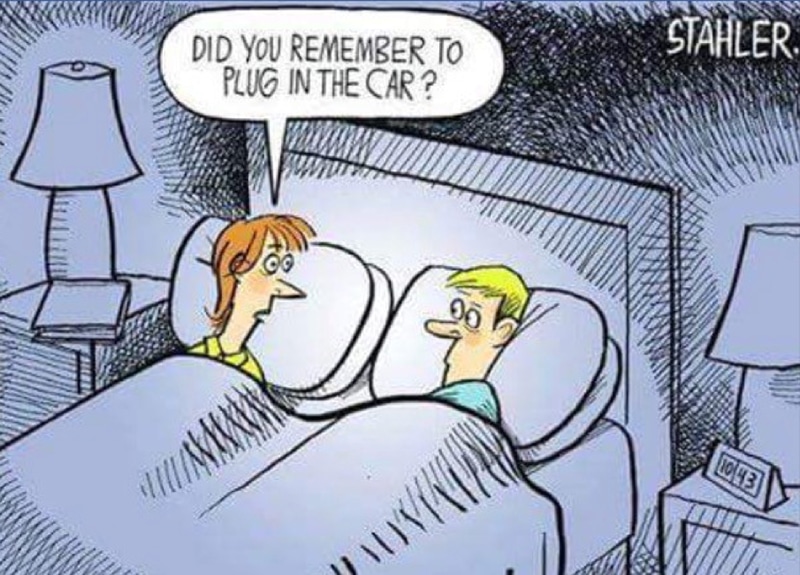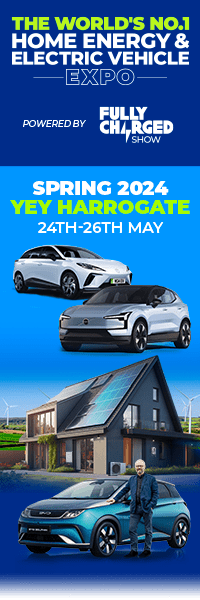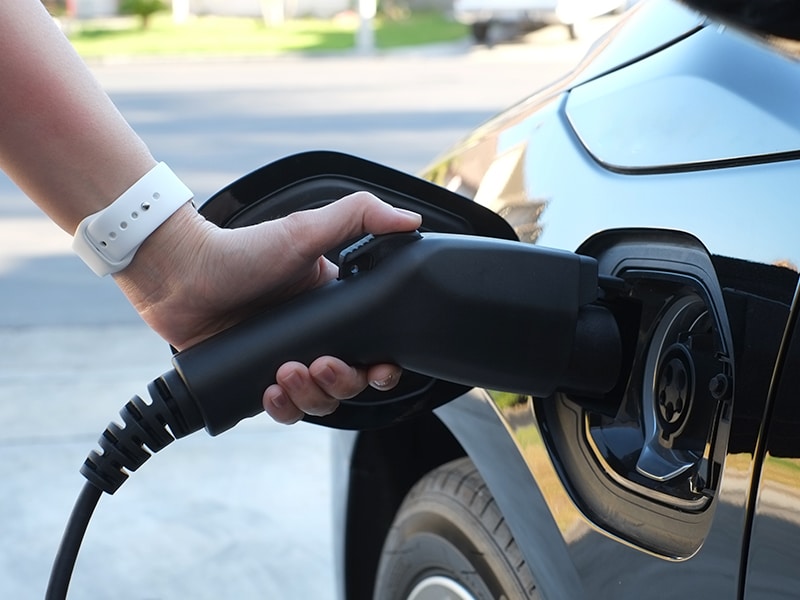
‘Two years ago, electric car chargers were few and relatively similar— now there are loads of options, and the tech is fantastic! So, how do you pick the right charge point? Rightcharge has just launched as the comparison site for electric car chargers and the founder, Charlie Cook, gives some tips on how to choose yours.’
Home and workplace chargers didn’t used to be that exciting. They were pretty much just high-powered sockets…!
But not anymore.
Now, electric car chargers are the tech that syncs your EV with the heartbeat of renewables, schedules your charge for the cheapest half-hours of the day, and chats with all of your other gadgets — your solar panels, battery, phone, and (of course), Alexa.
And choosing the right charger can actually save you over £200 a year. So, it’s worth having a quick look around before you pick yours.
Electric car smart chargers – how to cut your costs and carbon
Here’s the biggest secret of EV charging, for home or at work:
Hands-down the best way to get electrons into your electric car is to switch to a 100% renewable electricity tariff with an off-peak period, and then install a smart charger that can schedule your charge for the off-peak hours.
You will reduce your cost of charging by up to 70%, and cut the carbon going into your car by 25%.
If you’re like the average UK driver, you will drive around 8,000 miles per year, which works out to be about 2000 kWh used by an electric car. With a ‘normal’ home electricity tariff (e.g. a ‘Big 6 standard variable tariff’, costing around 17p / kWh) the cost of driving for a year will be about £340. If you switch to a tariff with an off-peak period, the rate can be as low as 5p / kWh during the night (usually from around mid-night until the early morning).
The same 8,000 miles will cost as little as £100 per year when charging off-peak, saving you £240 every year!
The trick is that you want to have a charger that will start charging automatically when the off-peak period kicks-in and stop when it ends. This way, you can get home, plug-in and get on with your evening.
And you don’t have to get out of bed at midnight to plug in, and again in the early hours to unplug.

Choose your electric car charger
You will also be reducing the carbon used for driving, as during the night most of our electricity comes from clean sources including wind and nuclear. On average, it’s 25% cleaner to charge at night than during the evening. The difference between peak and off-peak carbon can be even more at different times of the year.

It’s cleaner to charge your electric car at night than during the day
To spot the chargers that are capable of smart charging, look for the WiFi symbol next to the charger on Rightcharge.
How to charge your electric car from the sun – Solar Charging explained
Some chargers can monitor the electricity being generated by your solar panels, and the electricity being used by your home. This means your charger can know when you’re generating ‘excess solar’ (more electricity than you’re using in the home).
The first charger with Solar Charging functionality was the Zappi charger from MyEnergi (featured at the time on the Fully Charged Show). MyEnergi have been improving this tech ever since, and other chargers have recently come to the market with Solar Charging technology.
Taking the Zappi as an example, you can choose to:
- Charge immediately at full speed (taking as much grid power as you need)
- Plug-in but only charge when you begin generating excess solar (charging with solar only)
- Plug-in and ‘trickle charge’ (at a slow rate) from the grid and then increase the power as excess solar power increases (a combo of grid and solar)
Most chargers that are capable of Solar Charging are also capable of scheduling your charge for the off-peak hours. Since off-peak hours are almost always during the night you get the ideal charging experience with your car only charging when you’re generating solar during the day, or if you’re accessing cheap off-peak rates during the night.
And you’ll be able to drive purely on free, clean energy if your car tends to be home during the day.
Load Balancing explained – how you can avoid slow charging
Your home can only cope with so much power being used at once. The maximum you can use is dictated by your home’s Main Fuse, which is typically 60amp or 100amp in the UK.
It didn’t used to be uncommon for homeowners with a 60amp fuse to have to install a Slow charger (which draws less power), because a Fast charger (twice as powerful as a Slow charger) could trip your fuse if your appliances are on and your car is charging.
Load Balancing eliminates this problem. A charger with Load Balancing will monitor the total power being used by your car and your home. The charger will automatically reduce the power being delivered to the car if you creep up towards your fuse limit.
This way, you should be able to Fast charge whenever you’re not using your electric cooker, shower or your hot tub.
It’s also a key consideration if you have more than one charger at home.
Tethered vs untethered charge points explained
Fixed cable (tethered) or socket (untethered)?
This is the key thing to know — all electric cars have either a ‘Type 1’ socket or ‘Type 2’ socket. Type 2 is the new norm for new cars, but older cars may be Type 1.
- An untethered electric car charger gives you flexibility. You will need to use the car’s own charging cable with these chargers, so you can charge a Type 1 or Type 2 car.
- Have a Type 1 but might have a Type 2 in the future? Have a Type 2 but your friend has a Type 1? Untethered is for you.
- A tethered electric car charger gives you convenience. If you will only ever need to charge one type of car (say, your car is Type 2 and you’re happy for friends to charge from your 3-pin plug) then just unwind the cable from your tethered charger and plug in.
- Never will you have to grab your cable from your boot on a cold, wet, British winter’s evening.
Elvi from EVBox is an outlier here. It is cleverly designed with a replaceable cable or socket. So further down the line you can switch a socket for a tethered cable, or a Type 1 tethered cable with a Type 2 tethered cable.
Other electric car charge point features explained
We’ve touched on the core features, but here are some of the other things you might want to consider before picking your perfect charger:
- Lock and key. Dodgy neighbours? Look for a locking feature if you’re worried about coming home to find someone else plugged in. Some chargers use the traditional lock and key, but most with a locking feature can be controlled from your app. The Copper charger from Wallbox can be set to unlock with facial recognition! One glance and you’re good to go.
- Monitor & control. Chargers come with varying methods to control and monitor charging — smart phone, tablet, web-portal, Alexa, Apple Watch, buttons, touchscreen or a just a wave of your hand (the Wallbox Copper). Check the product’s description to see the level of sophistication.
- Earth Rod. An earth rod is a metal spike that needs to be sunk into the ground for most installs. Some products, including the Zappi and PodPoint Solo, come with earthing technology inbuilt — so there’s no need to disturb your drive or garden.
- RFID. RFID technology gives you the ability to hand out charging cards to your staff, customers or family. Each card is used to activate charging, and each charging session is recorded against that card. This way you can keep track of who is using what energy, and, with a few systems, you can automatically bill each user for what they’ve used (e.g. the Eve range from Alfen — excluding the Single S-line)
Compare electric car chargers on Rightcharge
Up until recently there hasn’t been a place to compare chargers side-by-side, which is why we built Rightcharge. Pop on over and start comparing the best electric car charge points today.
And if you have any questions, send me an email at charlie.cook@rightcharge.co.uk






